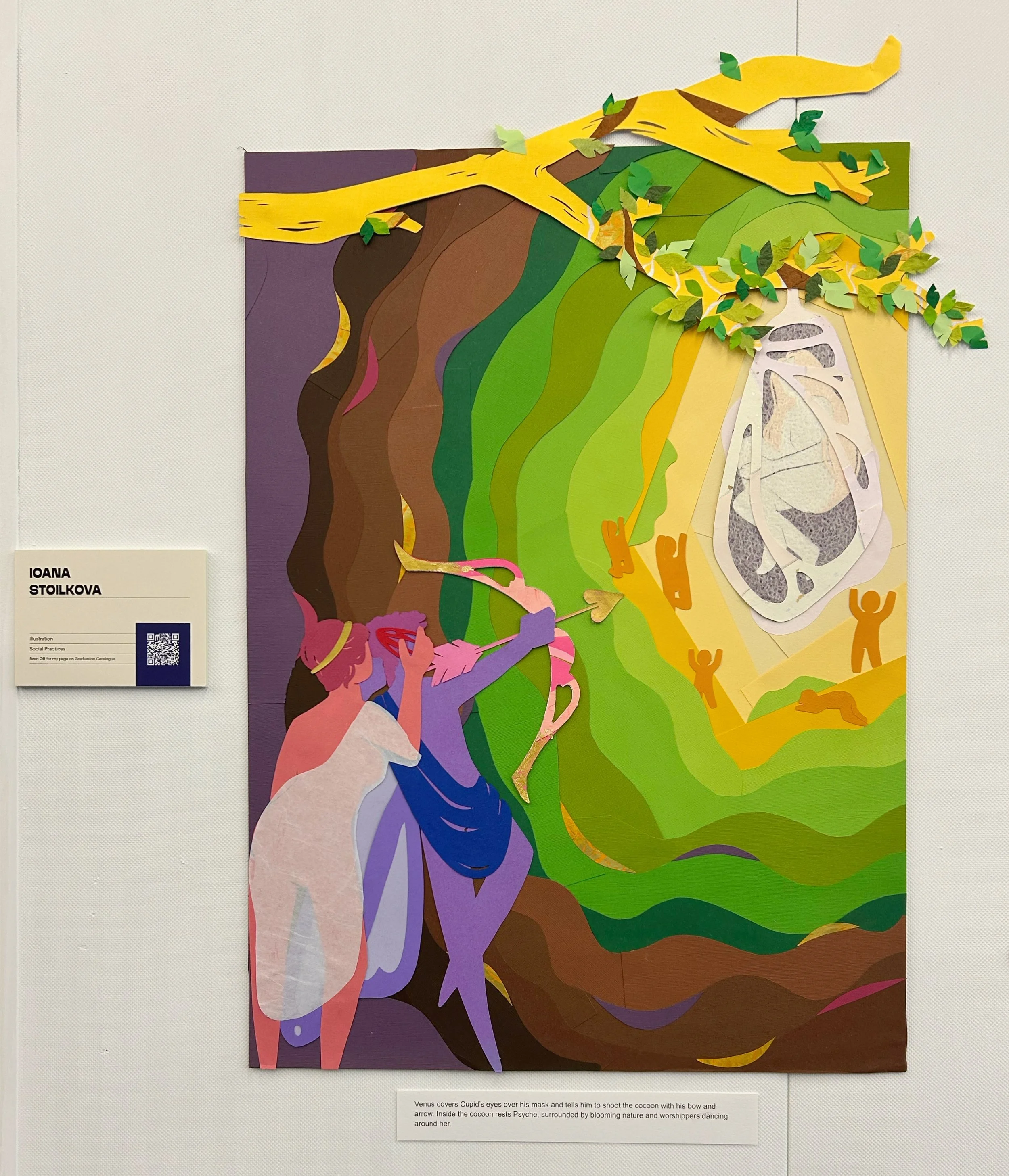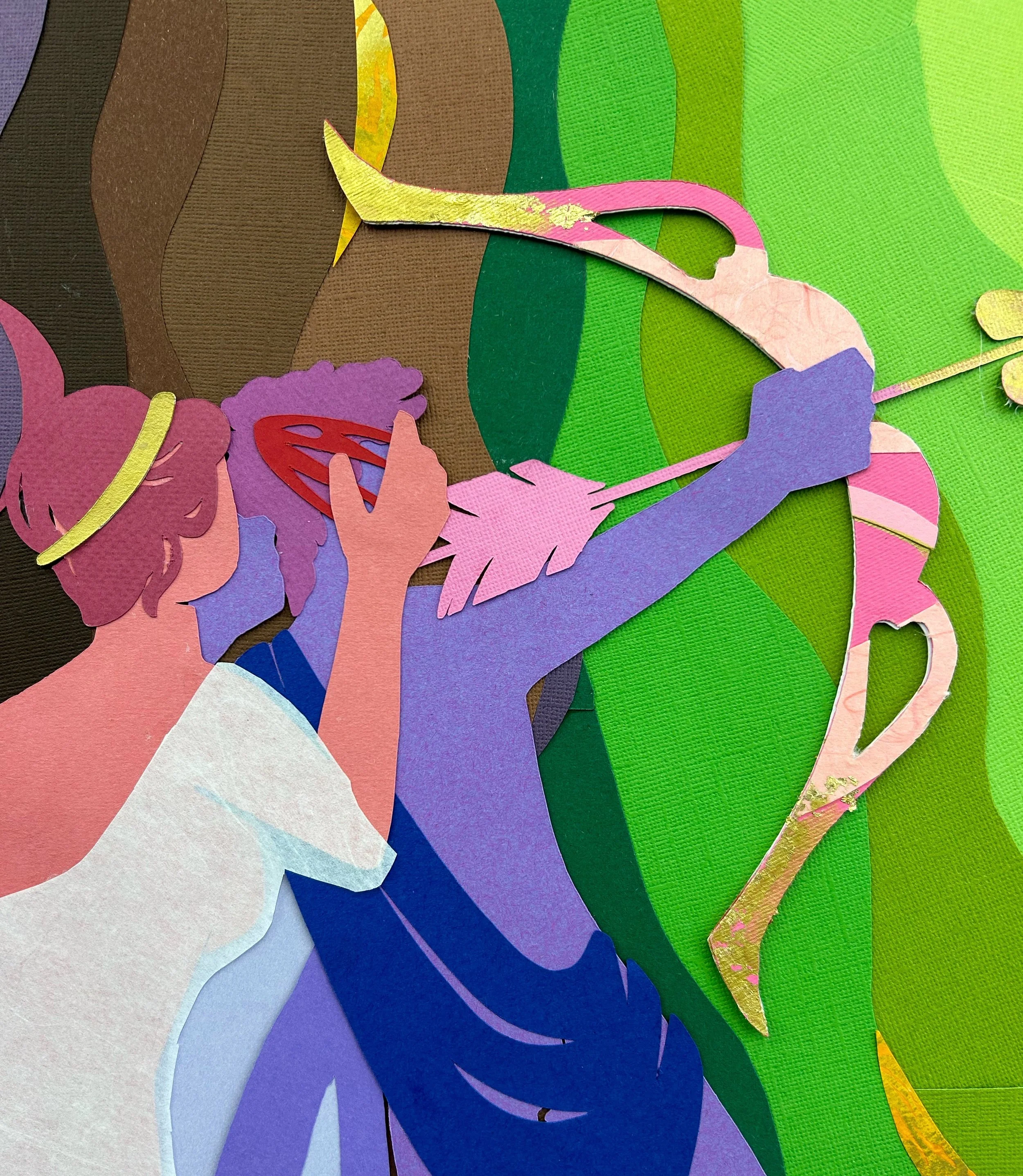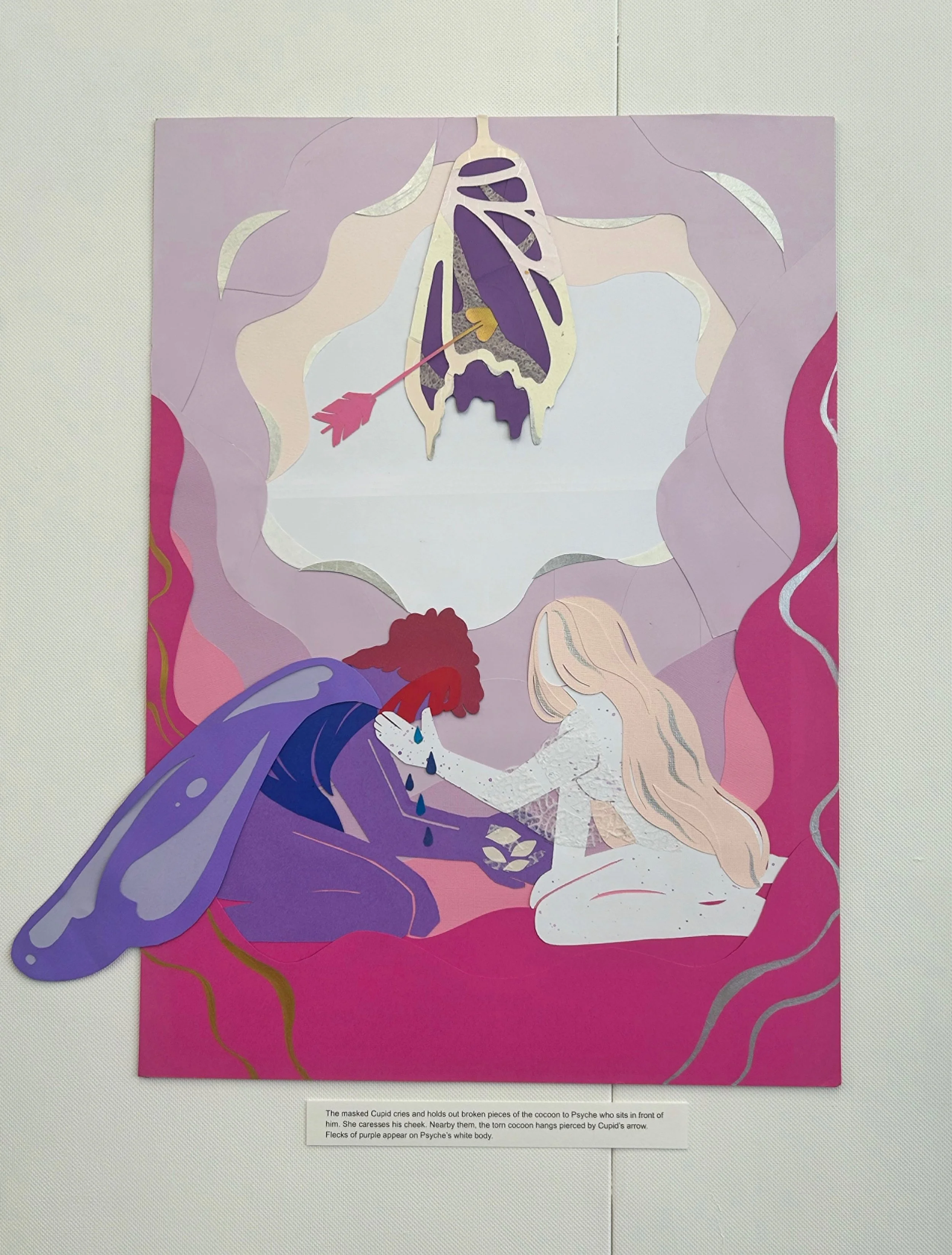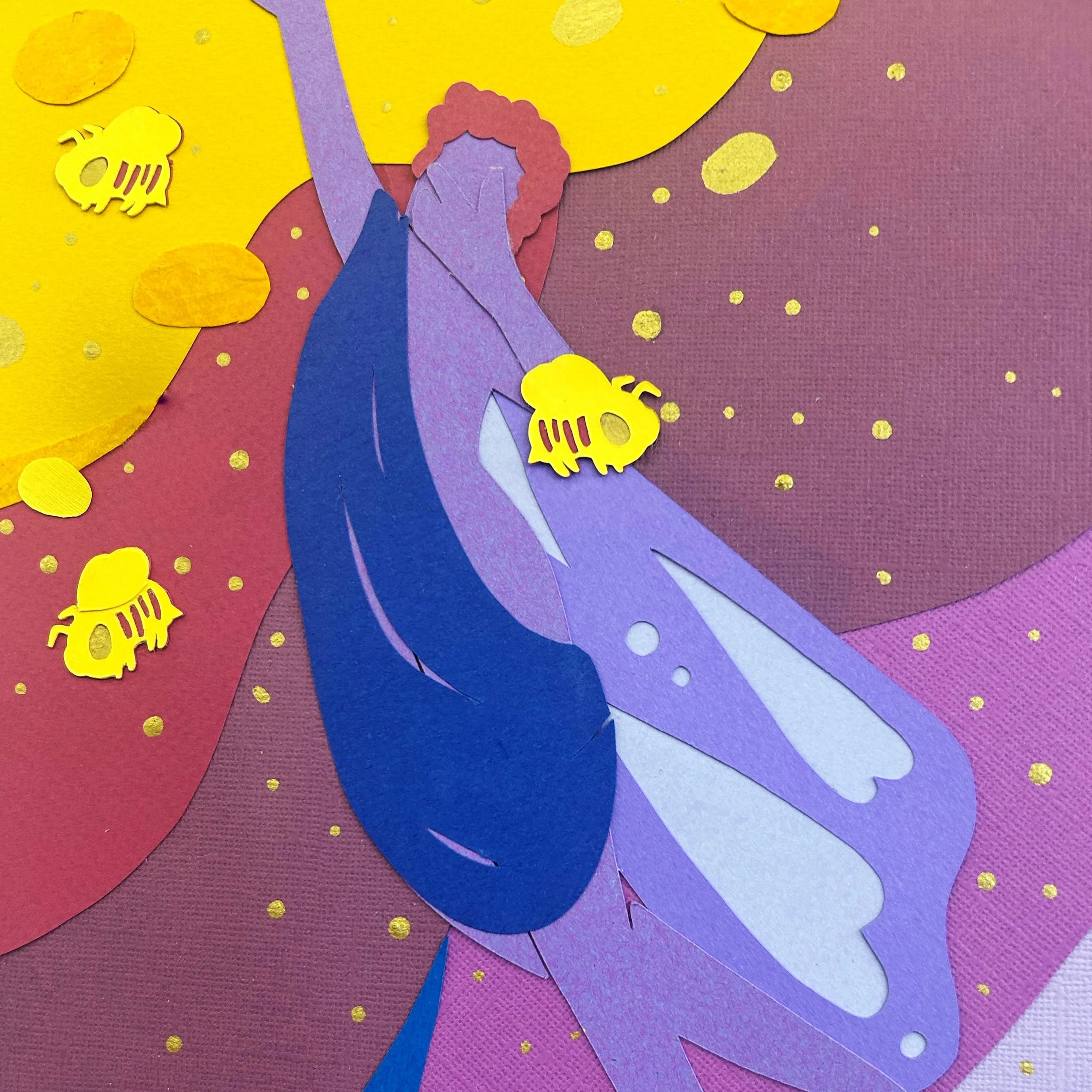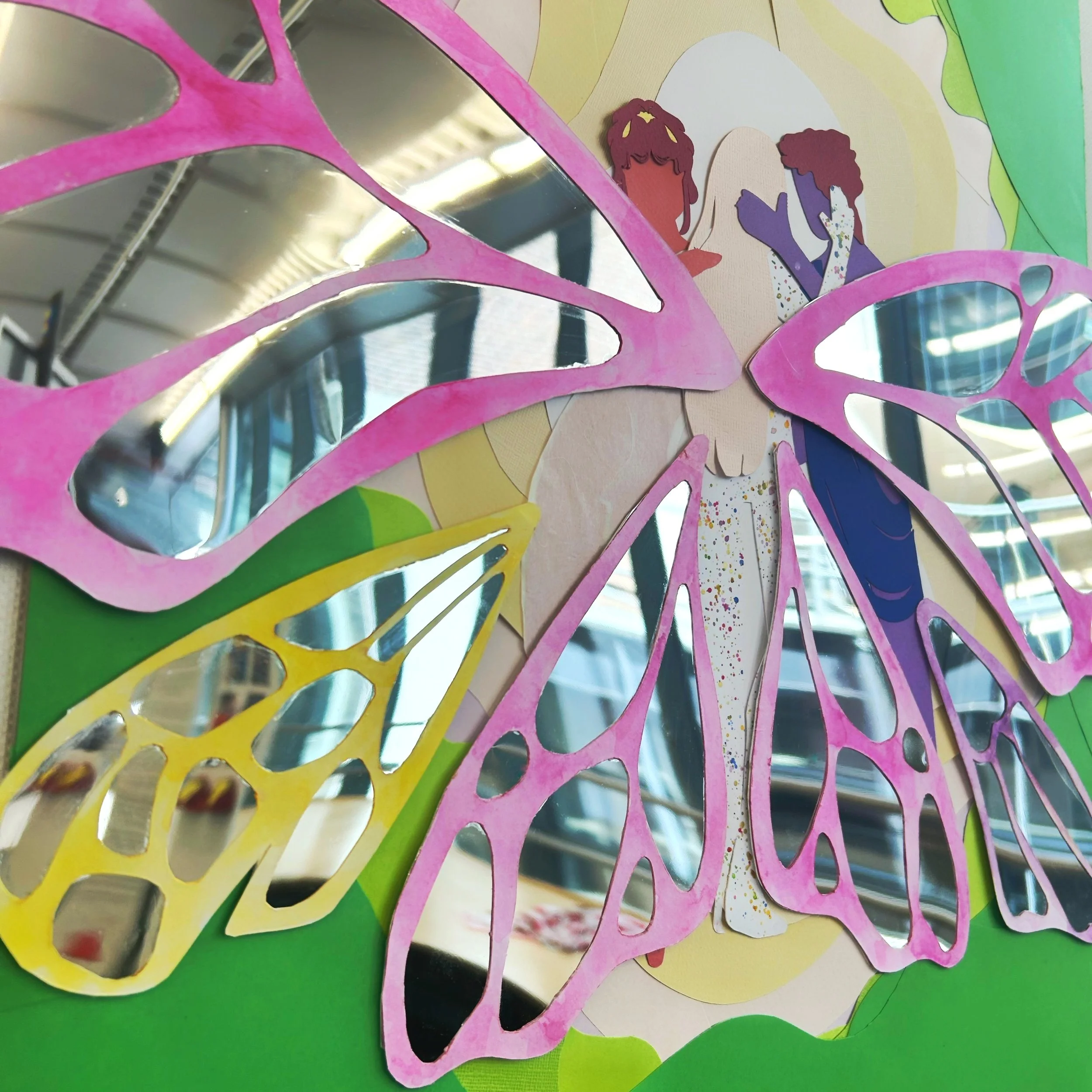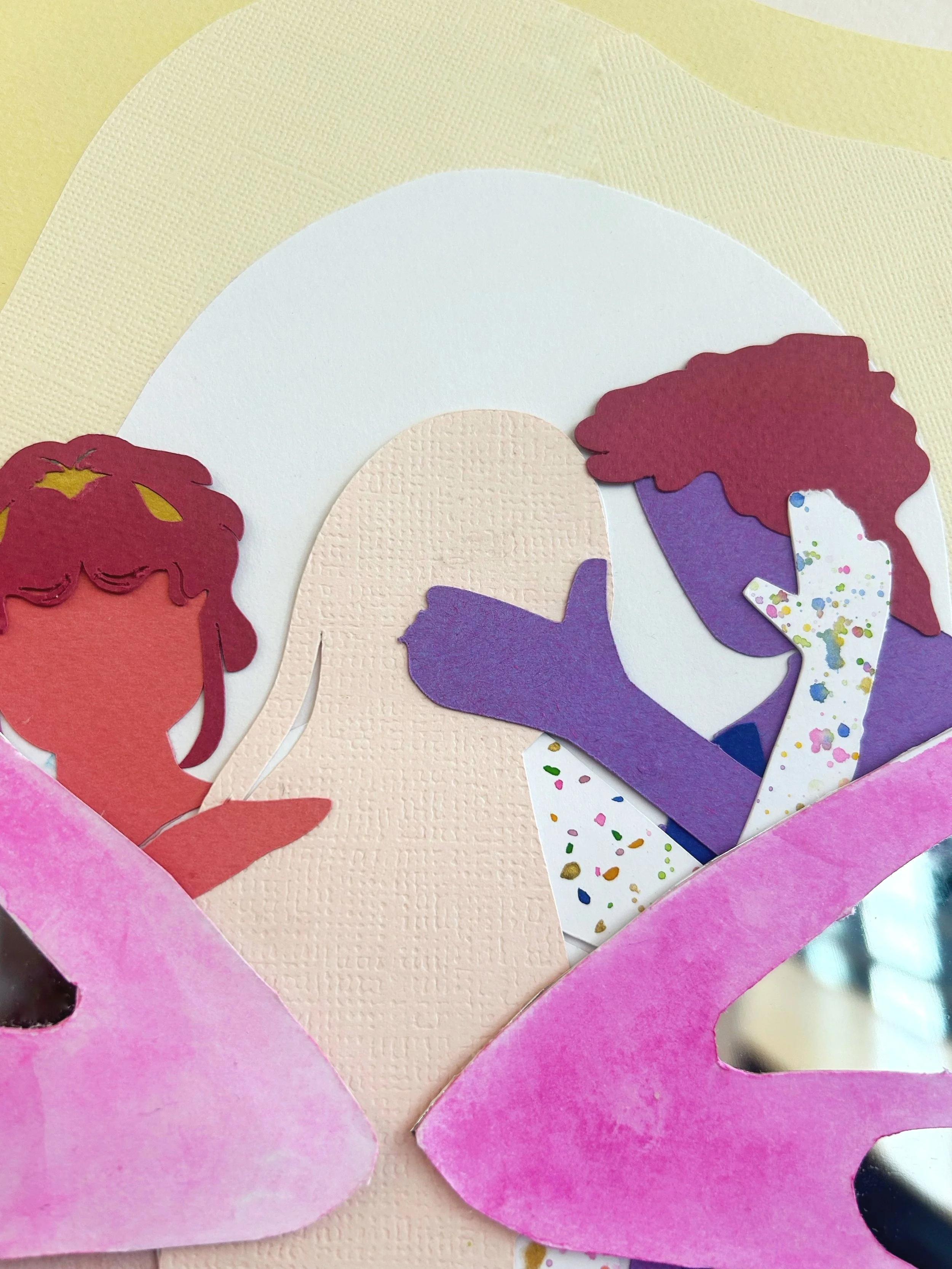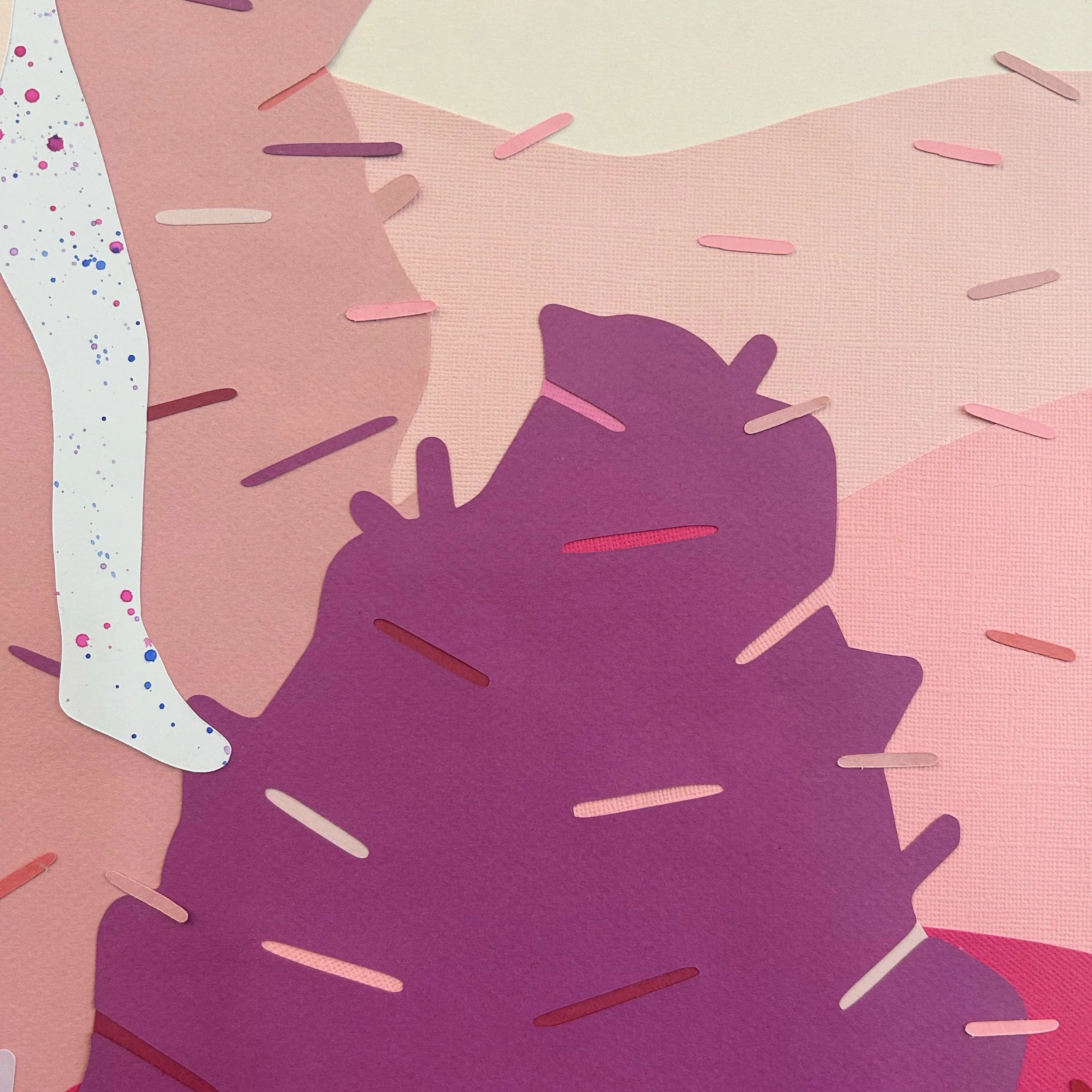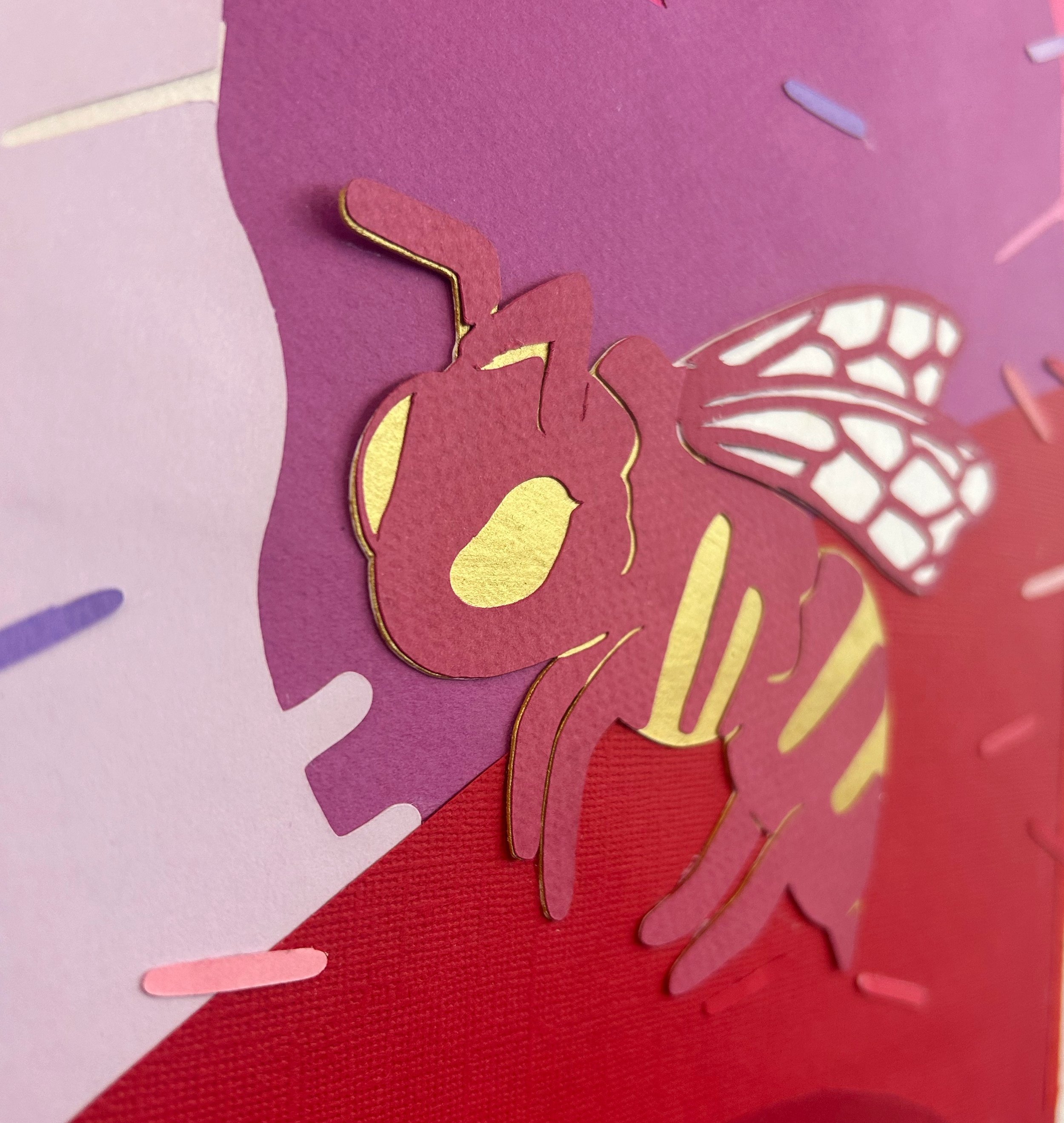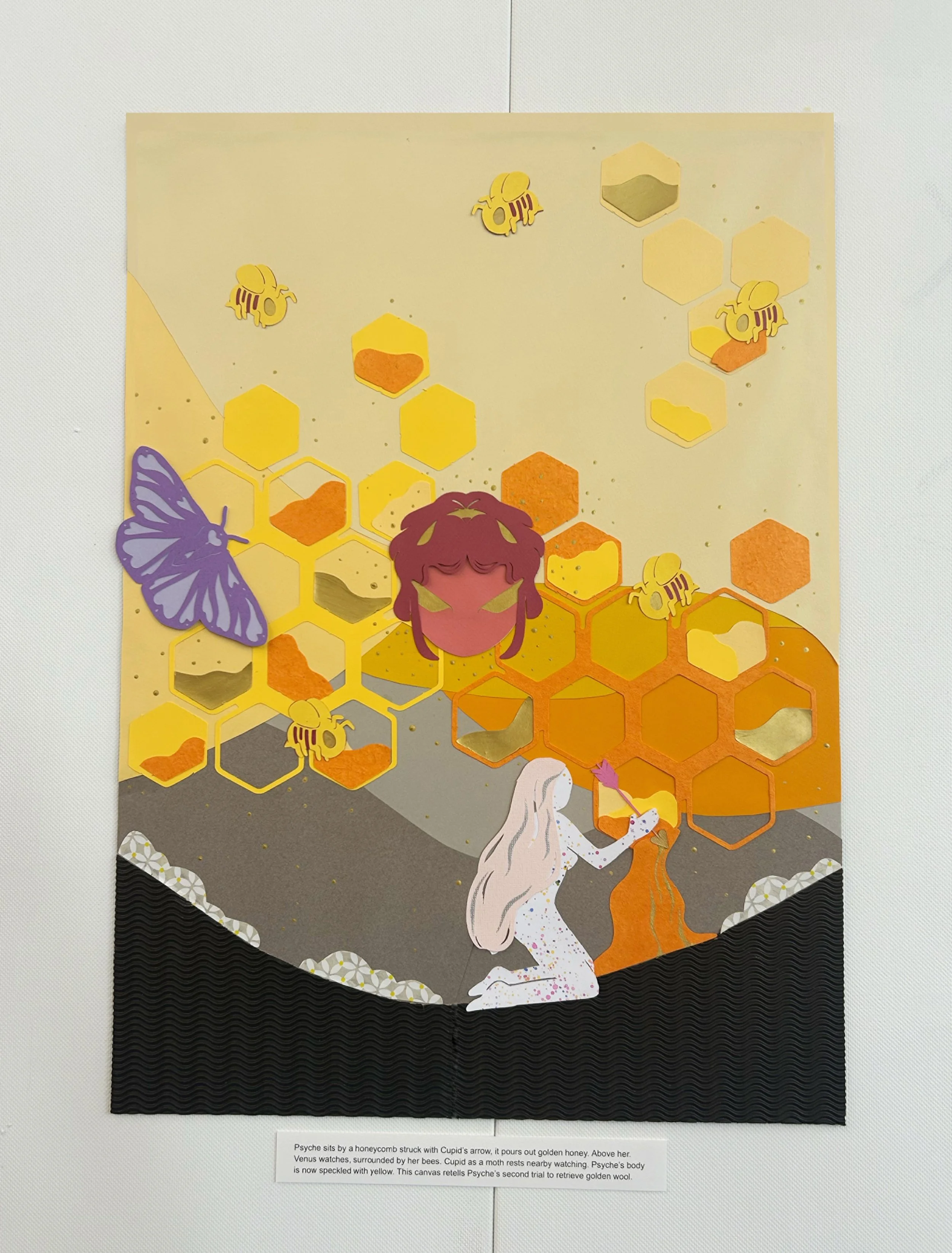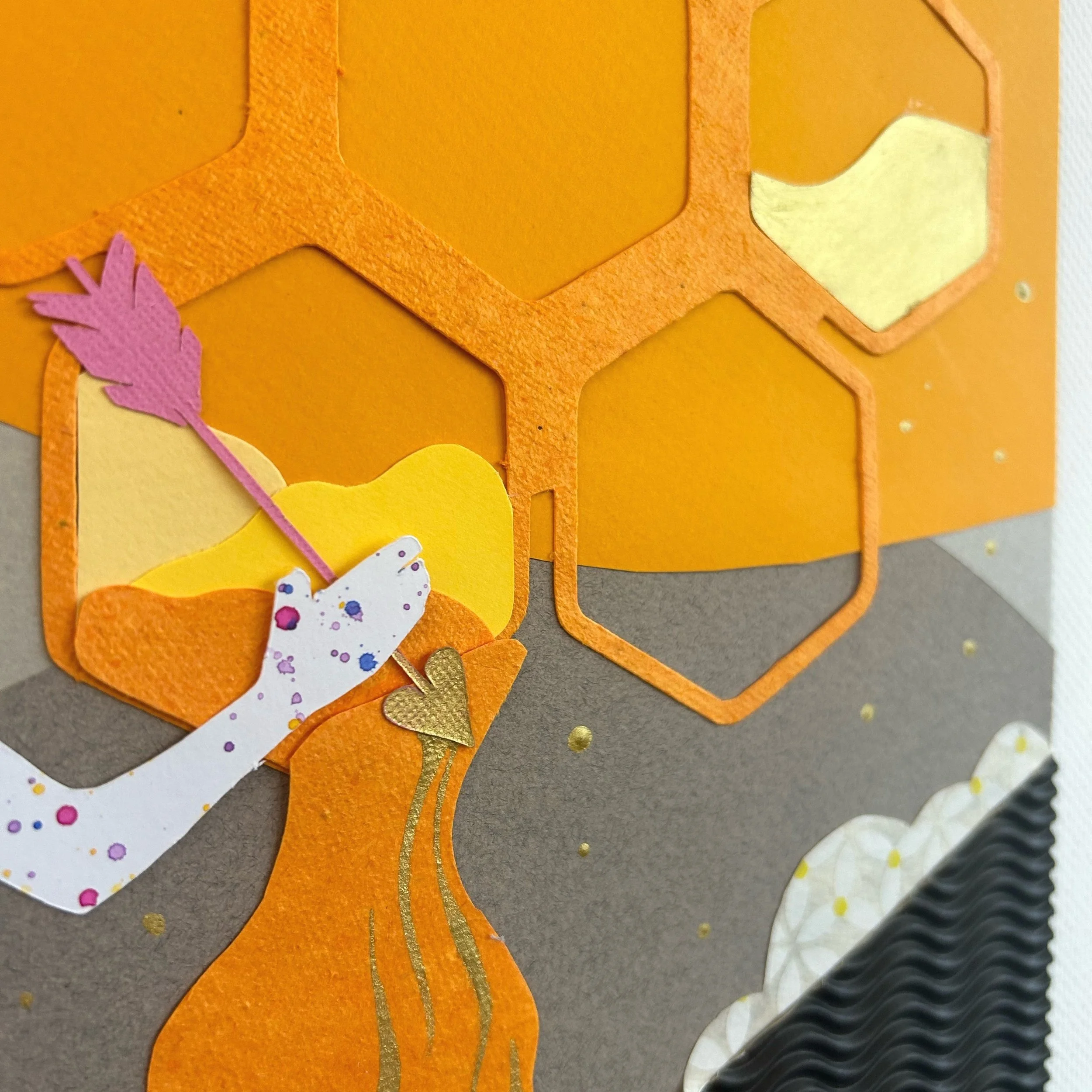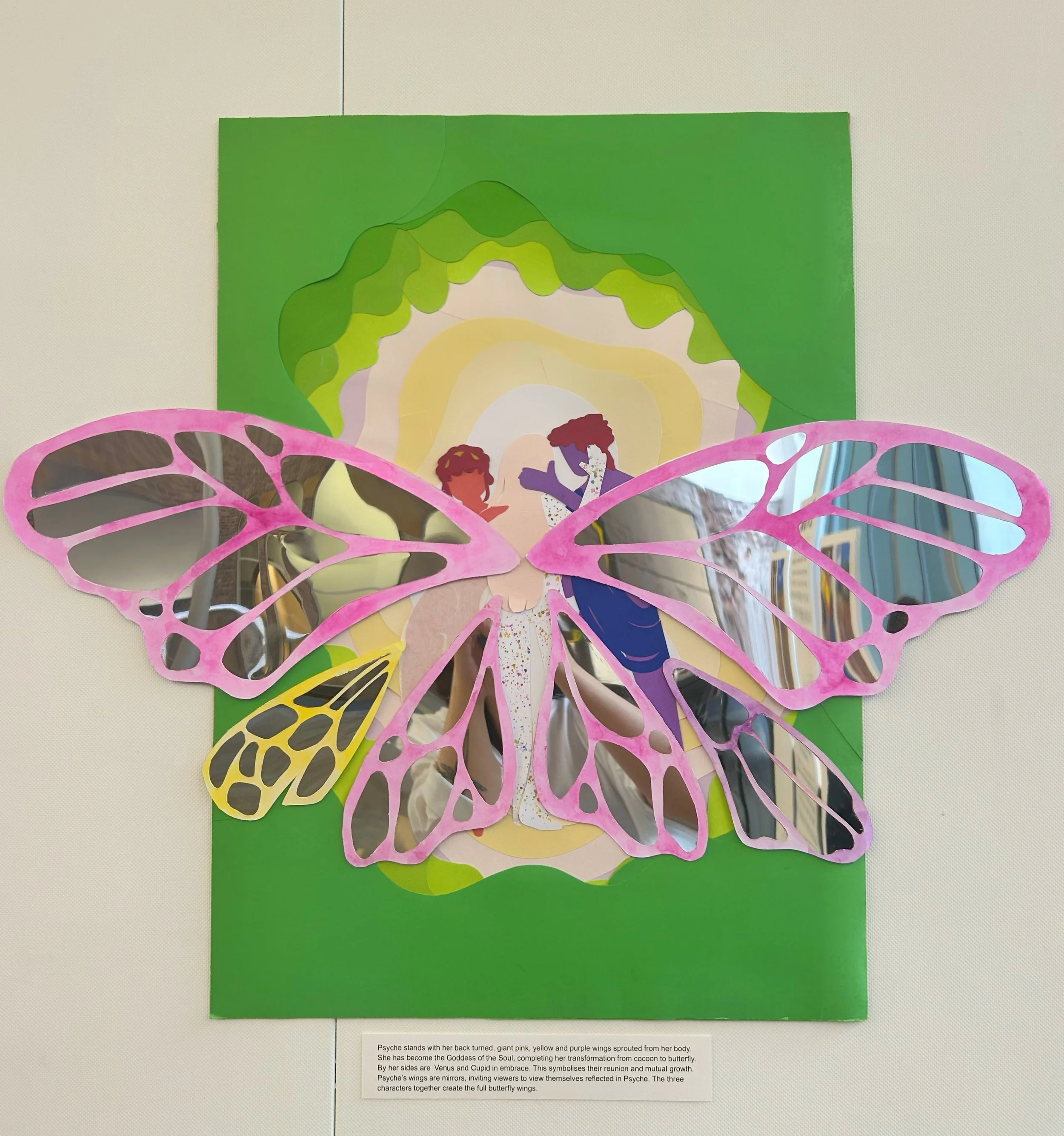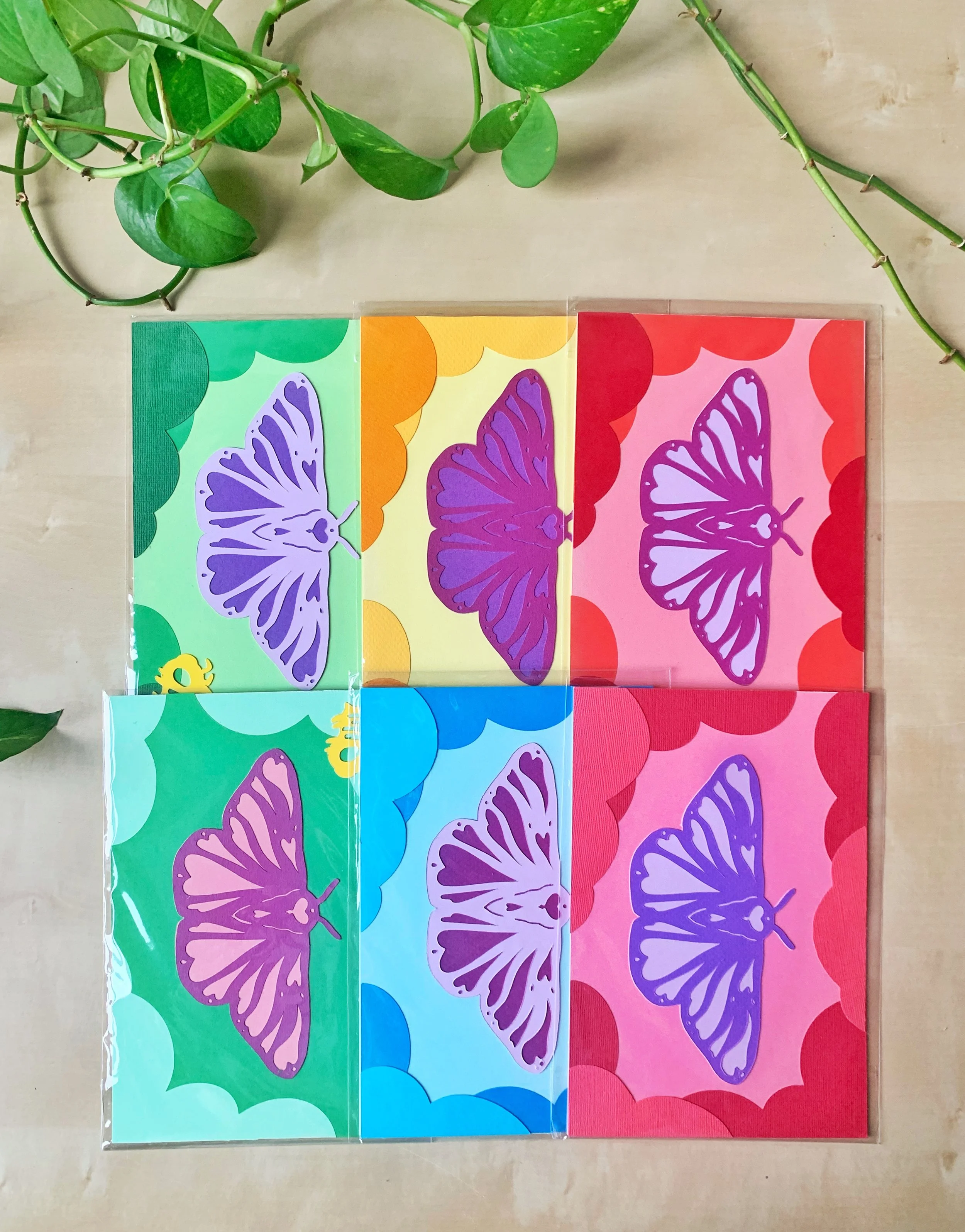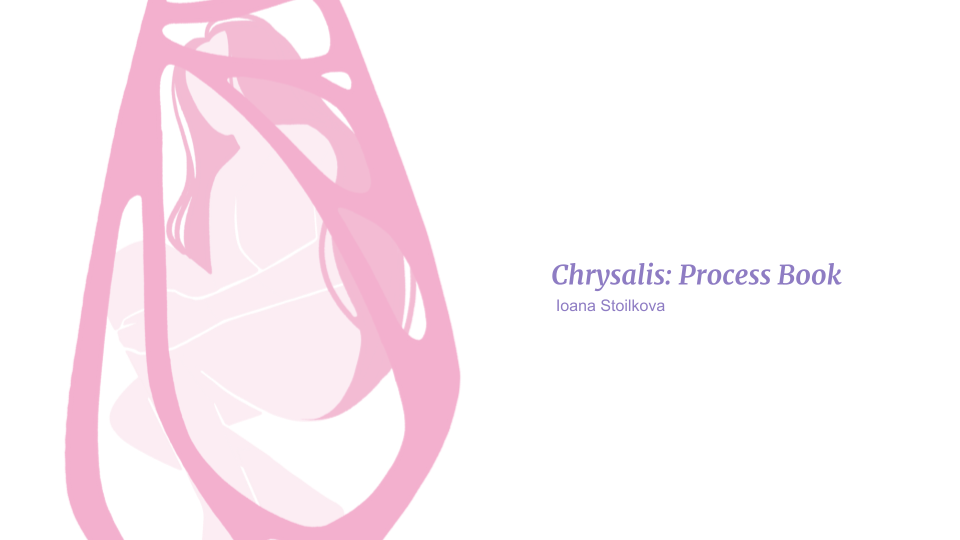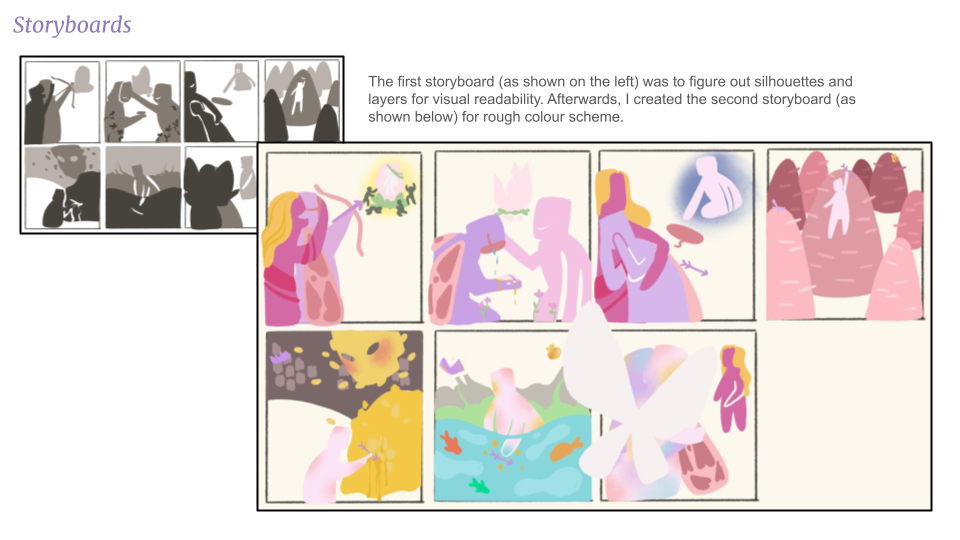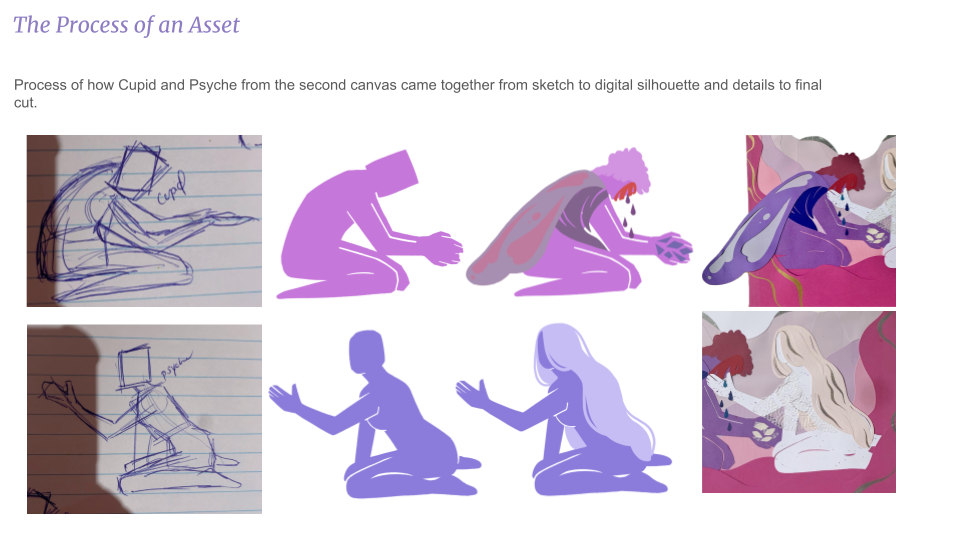Chrysalis
Chrysalis is a modern reimagining of the ancient Roman myth of Psyche and Cupid, presented through a series of seven layered paper canvases.
The focus of my retelling is the metamorphosis of Psyche from a mortal woman into the Goddess of the Soul, and the profound impact her transformation has on the gods: Cupid and Venus.
The characters’ emotional and spiritual journeys are reflected through the use of colours and insect symbolism. The visuals reflect the original myth, but the story is adapted to capture the emotional and spiritual journey of its protagonist.
Created as my graduation project, this work is featured in the Willem de Kooning Graduation Catalogue, which can be seen here.

The cocooned Psyche radiates and flourishes beneath a tree as people gather to worship her beauty. Jealous Venus conspires to her son Cupid, urging him to shoot Psyche with one of his arrows.
A masked Cupid seeks forgiveness from Psyche for tearing her cocoon and causing her to fall out. She kindly forgives him, and hues of Cupid's purple begin to bloom on Psyche's form.
A heartbroken Psyche reaches out for her beloved lover, but in her curiosity to learn her lover's identity, she has removed his mask in his sleep. This betrayal causes him to flee. Venus's bees swarm around Cupid, delighted to take him away from distraught Psyche. In his hurried departure, one of his arrows falls to the ground. As Psyche weeps, her tears form blue hues on her body.
After Cupid's departure, Venus assigns Psyche a series of cruel and impossible tasks, promising a reunion with her beloved upon completion. In the first trial, Psyche must sort through fields of arrows to find one of Cupid's discarded arrows. Nearby, Cupid as a moth and Venus as a bee observe her, their motives contrasting sharply. As Psyche works, pink hues bloom on her form, symbolizing her determination.
This canvas retells Psyche’s first trial sorting grains and seeds.
Psyche sits at the base of a towering golden honeycomb as she embarks on her second trial. She must carefully retrieve one of Cupid's arrows from a broken honey cell without provoking the nearby bees. Venus watches from her beehive, eager for her to fail while Cupid in his moth form quietly observes. As Psyche concentrates on the task before her, yellow hues begin to emerge across her body.
This canvas retells Psyche's second trial to retrieve golden fleece from a flock of golden rams.
Psyche dips her hand into the immortal waters below to retrieve the last of Cupid’s arrows. The golden ripples and intricate patterns alludes to a Godlike presence within the water. As she reaches for the arrow, vibrant green hues flow onto her skin. Framing her are the insect forms of Cupid and Venus, observing the young mortal’s unwavering resolution in her trials.
This canvas retells Psyche’s third and fourth trials of the underworld for a vial of water from Styx and a jar of Persephone’s beauty.
Psyche stands in a loving embrace with Cupid, her beloved, reunited at last. Beside them, Venus stands with approval, satisfied with Psyche's unwavering resolve and her triumph in completing the trials. Each challenge has left its mark upon Psyche, profoundly transforming her and shaping her soul into something greater. From her back, emerges large, reflective wings, seamlessly joined with wings from Venus and Cupid— a symbol of her metamorphosis from cocoon to butterfly, mortal to divine, shaped by their influence. In this moment, Psyche ascends as the Goddess of the Soul.
The mirrors in Psyche's wings invite viewers to glimpse into their own souls, reflected within the essence of the Goddess of the Soul.
Symbolism
In Chrysalis, each canvas is rich with symbolic details that reference the original myth, using insects and colours to visually narrate the story of Psyche and Cupid. The insect representations of Psyche, Cupid, and Venus emphasize themes of metamorphosis, drawing parallels between their divine roles and the natural habits of these creatures. These elements work together to deepen the storytelling, highlighting Psyche’s journey, her struggles, and her ultimate transformation into the Goddess of the Soul.
Butterfly Psyche
In classical art, Psyche is often depicted with butterfly wings. In Chrysalis, this is further explored by using the butterfly imagery as a representation of her transformation beyond her mortality. Psyche’s journey from mortal to goddess is likened to a butterfly’s life cycle. Through love, loss, perseverance and reunion, each trial and experience Psyche faces shapes who she becomes. In the final canvas, Psyche’s wings serve as a visual representation of her metamorphosis, but also as an embodiment of all her experiences that led to her ascension. The mirrored surface of her wings invite both mortals and gods to see their own souls reflected, a visual reinforcement of Psyche’s role as the Goddess of the Soul.
Moth Cupid
Cupid is portrayed as a moth to symbolize his nightly visits to Psyche. In the original myth, he would visit her at night in his dark palace to hide his true identity. Unlike butterflies, moths thrive at night and are symbols of secrecy and mystery. Cupid’s moth wings are adorned with heart-shaped patterns to reflect his role as the God of Love. Throughout the canvases, Cupid observes in his moth form over Psyche, even after her betrayal when she uncovered his identity. His quiet presence during her trials reflects his deep love for her as he continues to watch over and guide her from the shadows.
Queen Bee Venus
Venus, the Goddess of Love and Beauty is a powerful deity in Roman mythology, known for wielding immense influence over both mortals and gods. She is adored for her striking beauty and worshipped for her control over love, which can be generous and kind or fickle and vengeful. As such, she is depicted as a queen bee, a symbol of leadership and control. Despite her beautiful and delicate appearance, Venus and her bee counterpart hold a sharp sting to any who cross her. She rules her hive and expects loyalty and reverence from those around her. This insect symbolism reflects her duality of her beauty and power.
The Role of Colours
Colour plays a key role in the storytelling of Psyche and Cupid, visually representing Psyche's transformation. In the first canvas, she is encased in a cocoon, sheltered from the world, with a limited palette of white, pale pink, and silver. In the second canvas, her encounter with Cupid begins to change her—his purple hues appear on her body, marking the start of her evolution. As she continues her journey, the world around her leaves its mark, reflecting how human experiences shape us. By the final canvas, she is multicolored, embodying the many aspects of life she has endured. Through these experiences, she transforms into the Goddess of the Soul, enriched by all she has felt and learned.
Miniature Canvases
These pieces were created as smaller, more condensed versions of their larger canvases, designed to be sold as miniature paper works.
The Process
Behind the work on the canvases, was extensive research on the traditional myth and modern adaptations to create my own retelling.
(Please view on desktop for proper format)
